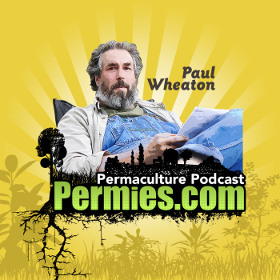 Listen Online
Listen Online  Download
Download  Get all of the Podcasts in convenient, giant zip files
Get all of the Podcasts in convenient, giant zip files  Subscribe on iTunes
Subscribe on iTunes Summary
Summary
Paul Wheaton and Alan Booker continue their review and discussion of the big black book,
Bill Mollison's Permaculture - a designers' manual.
Figure 1.1 Evolution from contemporary agriculture to a permaculture
Actual discussion of fig1.1 starts here.
I Cash (dollar) accounting
Bar 1: - income from total product on the farm.
Bar 2: - cost of producing that income in real terms (excess cost over income represents subsidies. Note that any farm 'profits' are achieved by subsidy, the dollar costs do not balance until organic farming is achieved. Farm income is achieved by reducing production costs).
II
Energy accounting
Bar 3: Oil (or calories) as machinery, fuels, fertilisers, biocides. Starts at 10:1 against (loss) in conventional farming, and can reach a 1:120 gain in conservation farming/permaculture with
firewood and fuels.
Bar 4: Energy produced on farm, includes fuel oils from crop, firewood, calories in food produced (
solar energy is a constant, but it contributes most energy in conservation farming/permaculture).
III Environmental accounting
Bar 5: Soil loss; includes humus loss and mineral nutrient loss.
Bar 6: Efficiency of water use and soil water storage.
Bar 7: Pollution produced (poisoning of atmosphere, soils, water) by fuels, biocides, and fertilisers. Soils are created in conservation farming/permaculture, water conserved and pollutants removed.
IV Conservation accounting: life from richness
Bar 8: Genetic richness in crops and livestock.
Bar 9: Soil life (biomass).
Bar 10: Forest biomass and wildlife richness.
Continued in part 3.
Relevant Threads
"Permaculture - a designers' manual" forum
The Big Black Book - summary, reviews,and where to buy
Support the Empire
Help support the empire and get all of the podcasts in a bundle
here in the digital market at permies.
To support production of these podcasts, make a donation
here at Paul's Patreon page.
 This podcast was made possible thanks to:
This podcast was made possible thanks to:
Dr. Hugh Gill Kultur
Eivind W. Bjørkavåg
Suleiman, Karrie, and Sasquatch
Bill Crim
anonymous
Kerry JustTooLazy
Jocelyn Campbell
Wade Luger
Sasquatch
Kyle Neath
Chris Sugg
havokeachday
Bill Erickson
Dominic Crolius
Julia Winter, world's slowest mosaic artist
G Cooper
Penny McLoughlin
Ash Jackson
Mehron Kugler
Lisa Goodspeed
Mark
Pasquale DeAngelis
Sean Benedict
Greg Martin
Rita Bliden
Dana Martin
Candace Dahlk
Keith Kuhnsman
Eric Tolbert
Ruwan Nanayakkara
Polly Jayne Smyth












